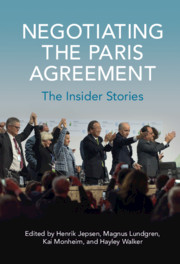Book contents
- Negotiating the Paris Agreement
- Negotiating the Paris Agreement
- Copyright page
- Contents
- Figure
- Editors
- Contributors
- Acknowledgments
- Foreword
- 1 Introduction
- 2 The Paris Negotiations: Background and Context
- 3 The French COP 21 Presidency
- 4 Mission: Adoption with Ovations: The Contribution of the UNFCCC Secretariat to the Achievement of the Paris Agreement
- 5 The Paris Agreement and China’s Imprint
- 6 The EU’s Role in the Paris Agreement
- 7 The United States: Interesting Processes and Techniques Lined the Road to Paris
- 8 COP 21 – Complaints and Negotiation: The Role of the Like-Minded Developing Countries Group (LMDC) and the Paris Agreement
- 9 The Staircase of Paris
- 10 The Battle for Small Island Developing States
- 11 The High Ambition Coalition
- 12 The Power of Civil Society
- 13 Business: Creating the Context
- 14 Why Did They Finally Reach Agreement?
- 15 Conclusion: The Landscape of Multilateral Agreement in Paris and Beyond
- Afterword
- Appendix: The Paris Agreement
- References
- Index
13 - Business: Creating the Context
Published online by Cambridge University Press: 24 September 2021
- Negotiating the Paris Agreement
- Negotiating the Paris Agreement
- Copyright page
- Contents
- Figure
- Editors
- Contributors
- Acknowledgments
- Foreword
- 1 Introduction
- 2 The Paris Negotiations: Background and Context
- 3 The French COP 21 Presidency
- 4 Mission: Adoption with Ovations: The Contribution of the UNFCCC Secretariat to the Achievement of the Paris Agreement
- 5 The Paris Agreement and China’s Imprint
- 6 The EU’s Role in the Paris Agreement
- 7 The United States: Interesting Processes and Techniques Lined the Road to Paris
- 8 COP 21 – Complaints and Negotiation: The Role of the Like-Minded Developing Countries Group (LMDC) and the Paris Agreement
- 9 The Staircase of Paris
- 10 The Battle for Small Island Developing States
- 11 The High Ambition Coalition
- 12 The Power of Civil Society
- 13 Business: Creating the Context
- 14 Why Did They Finally Reach Agreement?
- 15 Conclusion: The Landscape of Multilateral Agreement in Paris and Beyond
- Afterword
- Appendix: The Paris Agreement
- References
- Index
Summary
Stephen Howard, who served at Chief Sustainability Officer at the IKEA Group and co-founded the “We Mean Business” Coalition, describes how the role of businesses has evolved and how businesses created positive dynamics for COP 21. In the 2000s, well-organized business lobbies were pushing against climate action, and COP 15 left Howard frustrated. Trying to change things, in 2014 Howard and others formed the We Mean Business Coalition and major companies made commitments to 100 per cent renewable energy. The events, Howard assesses, created a new dynamic, as policymakers understood that some businesses considered climate inaction a danger to jobs and growth. At COP 21, businesses pushing for climate action used a high level of organization, clear policy asks, and repeated messaging to create a context that made it easier for negotiators and politicians to reach agreement. Howard assesses that such context was critical, and he doubts that the deal would have happened without the business community. Going forward, Howard’s advice is to differentiate the business community into separate groups and work with each of them in different ways.
- Type
- Chapter
- Information
- Negotiating the Paris AgreementThe Insider Stories, pp. 265 - 283Publisher: Cambridge University PressPrint publication year: 2021
- 1
- Cited by

